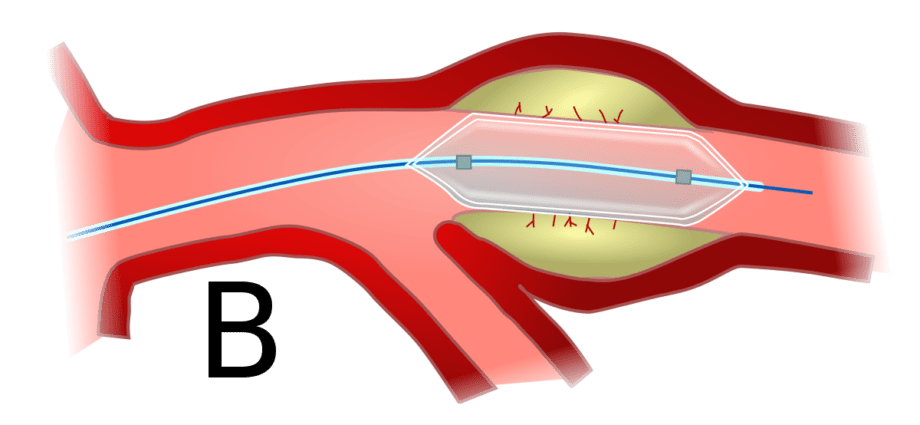Contents
Angioplasty
Angioplasty is one way to manage coronary artery disease. It is performed to unclog one or more coronary arteries without an operation. This angioplasty is often accompanied by the placement of a stent to prevent the artery from being blocked again.
What is coronary angioplasty?
Coronary angioplasty or dilation restores blood flow to one or more blocked coronary arteries. When one or more coronary arteries are narrowed (known as stenosis) by deposits of fat or blood clots (atherosclerosis), the heart is no longer sufficiently supplied and does not have enough oxygen. This causes pain and a feeling of tightness in the chest: it is angina pectoris. When a coronary artery is completely blocked, there is a risk of myocardial infarction. An angioplasty makes it possible to “unblock” the coronary arteries, without operation (unlike coronary bypass surgery). It is a gesture of interventional cardiology.
Angioplasty with stenting
Coronary angioplasty is completed by placing a stent in 90% of cases. The stent is a prosthesis that takes the form of a small spring or perforated metal tube. It is placed on the wall of the artery during angioplasty. It keeps the artery open. There are so-called active stents: they are coated with drugs that reduce the risk of new artery obstruction despite the stent.
How is an angioplasty performed?
Preparing for an angioplasty
This angioplasty procedure is performed after a coronary angiography, an examination allowing the visualization of the coronary arteries to be treated.
Before the procedure, an electrocardiogram, a stress test and blood tests are performed. The doctor will tell you which medicines to stop, including blood thinners.
Angioplasty in practice
You return to the hospital 24 to 48 hours before the operation, to perform all the examinations. About 5 hours before, you are no longer allowed to eat or drink. You take a betadine shower. Before the procedure, you take a tablet which is intended to relax you.
Angioplasty with or without stenting is performed under local anesthesia in an interventional cardiology room. You stay awake and the doctor may ask you to block your breathing or cough during the procedure to see your heart better or to speed up your heart rate.
A catheter with an inflatable balloon at its end is introduced from an artery in a leg or arm.
After injection of a contrast product, the probe is gradually brought into the blocked coronary artery. The balloon is then inflated, which crushes the atheromatous plaque and unclogs the artery. A stent is mounted on the balloon if placement of a stent is required. While inflating the balloon, you may experience transient pain in your chest, arm, or jaw. Report it to the doctor. After placement of the stent, the lead is removed and the arterial pathway is compressed with a compression bandage or closure forceps.
This procedure lasts from one to two hours in total.
In which cases is an angioplasty done?
An angioplasty is performed when one or more coronary arteries are stenosed, which causes symptoms such as chest pain, a feeling of tightness in the chest, shortness of breath on exertion (angina) or an acute coronary syndrome (heart attack). myocardium).
After angioplasty
The aftermath of an angioplasty
After coronary angioplasty with or without stenting, you are taken to the monitoring room and then to your room. You should lie down for a few hours, without bending your arm or leg towards the puncture. The medical staff will come to check your blood pressure, your pulse and the appearance of the puncture site regularly. You can have a snack or a light meal 3 hours after an angioplasty. It is necessary to drink a lot to promote the elimination of the injected contrast product.
You can be discharged from the hospital the day after the operation at the latest, unless this operation was performed in the context of an acute coronary episode (such as a myocardial infarction). For the first 48 hours, you must rest and you cannot drive or carry heavy loads. If you feel pain or have bleeding, contact your doctor. You can return to work the week following an angioplasty except in the event of a heart attack.
The results of angioplasty
The results of angioplasty are generally very good. It improves the course of myocardial disease in the long term.
There is a risk of recurrence of the stenosis, re-stenosis: 1 time out of 4 or 5, the narrowing of a coronary artery reappears gradually, generally in the first 6 months following angioplasty. A new angioplasty can then be performed.
Life after angioplasty
Once home, you should take antiplatelet therapy regularly and adopt a healthy lifestyle, to prevent the arteries from becoming blocked again. It is thus advisable to stop smoking, to resume a regular physical activity, to have a balanced diet, to lose weight if necessary and to better manage your stress as well as to ensure the control of hypertension, diabetes, high cholesterol with your doctor.










